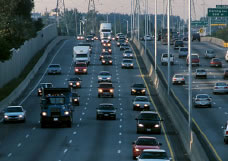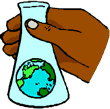|
We've come to accept the assertion that some level of air pollution and water pollution is OK; or, if not OK, that it's necessary to allow a modern lifestyle. But is this true?
What if we told automotive engineers: "Design a car so that it's acceptable to take the tailpipe and put the exhaust directly back into the passenger compartment." We car owners would insist that such an approach to pollution control would produce air that is pure. What if we told industrial-plant designers: "Make the effluent from your factory clean enough so that your CEO can use it as a drinking-water supply." Now THAT would be clean! The good news is, these seemingly unachievable pollution-control goals are indeed possible to reach.
 We all breathe the air that our tailpipes pump pollution into, but the pollutants are diluted because the volume of air they occupy is larger than the volume of air in our immediate breathing space. When there was only one car on the planet, the amount of air pollution it produced was irrelevant to the cleanliness of the total volume of air. At some point, as more and more cars were added, the cumulative amount of air pollution they produced got to be enough that even when
diluted in the larger volume of air in a given region, the air-pollution levels started being high enough to cause health problems. Emission standards were enacted, and air pollution levels started falling again. But as we keep adding more and more cars—with lower-mileage, higher-polluting vehicles comprising a larger portion of them—and as we continue driving more miles per person—advances in air-pollution-control technology have started losing some of their effectiveness in terms of how clean the air is overall.
We all breathe the air that our tailpipes pump pollution into, but the pollutants are diluted because the volume of air they occupy is larger than the volume of air in our immediate breathing space. When there was only one car on the planet, the amount of air pollution it produced was irrelevant to the cleanliness of the total volume of air. At some point, as more and more cars were added, the cumulative amount of air pollution they produced got to be enough that even when
diluted in the larger volume of air in a given region, the air-pollution levels started being high enough to cause health problems. Emission standards were enacted, and air pollution levels started falling again. But as we keep adding more and more cars—with lower-mileage, higher-polluting vehicles comprising a larger portion of them—and as we continue driving more miles per person—advances in air-pollution-control technology have started losing some of their effectiveness in terms of how clean the air is overall.
So, back to the idea of designing a car so that it's OK to take the tailpipe and put the exhaust directly back into the passenger compartment. That would be a very obvious way for a car owner to assess whether the exhaust from his or her car was "clean enough," and a consumer would not buy a car that allowed carbon monoxide, sulfur dioxide, nitrous oxides, and other pollutants into their immediate breathing space.
But is that just a tail-pipedream? No. Zero-emissions vehicles already exist in two types: battery-powered vehicles and hydrogen fuel-cell vehicles. These designs, however, still have enough kinks to be worked out that they are not practical for widespread implementation at this time. Still, we now see that our goal of garnering a tremendous reduction in vehicular air pollution is possible, given technology, time, and will.
Another "zero emissions" example can be formulated for industrial water pollution. Although waterways in the US and other Western countries have gotten cleaner since the bad ol' days of the 1960s, they are still not nearly clean enough. In the US, for instance, more than a third of our surface waters are still beset by water pollution and are considered unsafe for fishing or swimming—let alone drinking.
But is it realistic to think that we could eliminate toxic chemicals from manufacturing and that we can make things in an industrial setting without producing water pollution? Yes. As an example, let's talk about a Swiss textile mill where this was done.
Rohner Textil, a Swiss textile mill, was a typical high-pollution plant, until they hired a consulting firm that helped them get into green design and green manufacturing. We all like to think that the clothes we wear are non-chemical in nature, but the typical clothing manufacturing plant uses lots of chemicals—dyes, fixers, etc—and
 the output is not what you'd call clean. If most of the chemicals suddenly weren't available for use, would the Rohner Textil mill still be able to operate and produce clothes that people want to buy?
the output is not what you'd call clean. If most of the chemicals suddenly weren't available for use, would the Rohner Textil mill still be able to operate and produce clothes that people want to buy?
You bet'cha.... Though they had to eliminate many toxic chemicals and change some of their manufacturing processes, Rohner Textil continued making fabric profitably and avoided the costs associated with filling out government reports on stored toxics and waste-water pollution—they were that clean. In fact, the waste water from their process is as clean as Swiss drinking water. The CEO is perfectly willing to drink it! At a time when most textile operations have fled the West to the cheap labor markets of the East, Rohner Textil continues to do just fine in Switzerland—because of their switch to green design/green manufacturing.
When we speak of reducing air and water pollution, what we're really talking about is innovation in design. Ideally, a manufacturing process should be designed so that every byproduct is useful again within that process or is useful as an input to some other process. In this way, there is no pollution to dispose of.
Green design, green manufacturing, and green chemistry all work to move from toxic inputs to ecologically sound inputs, and they design processes so that waste products are less toxic and are rerouted back into productive use.

Life-cycle design, a concept that is part of green design, looks at the product itself to make sure that when its useful life is over, it can easily be disassembled and its components put back into the input stream. That is a paradigm shift relative to what we have been used to.
Europe has recently enacted laws that require manufacturers to take responsibility for the safe disposal of electronic equipment. This has forced manufacturers to rethink their approach to product design. Now, rather than just thinking "How can we design this to be attractive, functional, and inexpensive," they also have to add "and cheap to recycle or dispose of properly." One would think that such a big change would be hugely expensive and damaging to Europe's manufacturing economy, but it's estimated that the potential impact to sales is only 1% to 4%. That's still not trivial, but manufacturers who change their designs to better account for the end-of-life recycling/disposal requirement will make their operations more efficient and gain an advantage. And anyway, wouldn't you be willing to pay 1%-4% more for goods (or have 1%-4% less stuff over your lifetime) to be able to live in a world with far less pollution?
Pie-in-the-sky goals like zero emissions cars, no-effluent factories, and recyclable electronics are, in fact, realistic. We—the people who breathe air and drink water—should rightly expect that corporations will expand their thinking in this area, make appropriate investments, and stop polluting unnecessarily. We should also expect government to help them think in this direction by enacting laws that further limit air pollution and water pollution.
Know someone who might find this Water Pollution/Air Pollution article interesting? Please forward it to them
Resources:
Books:
- See books related to water pollution, air pollution, and green design
More articles and resources on....
Get Grinning Planet free via email
|


